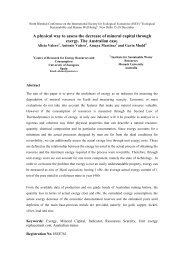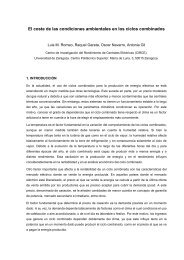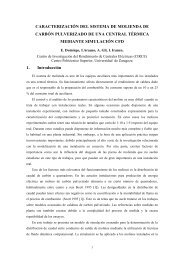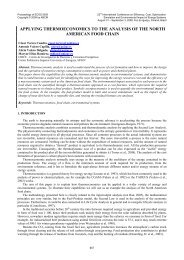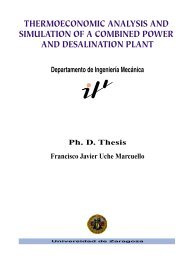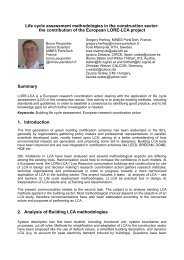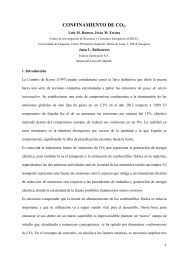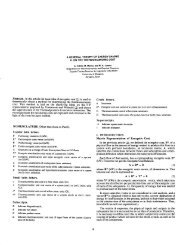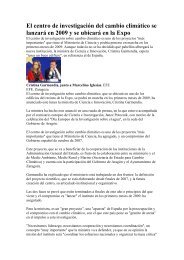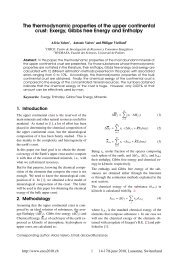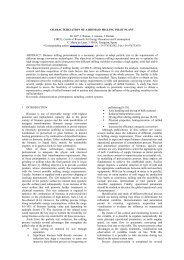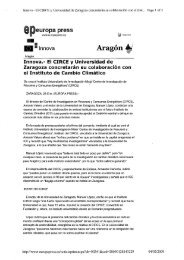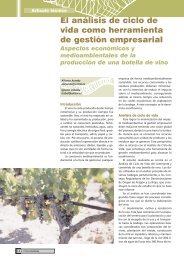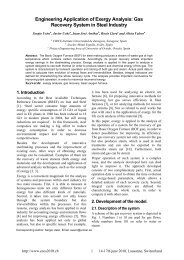building operation windows. an effective tool for improving ... - circe
building operation windows. an effective tool for improving ... - circe
building operation windows. an effective tool for improving ... - circe
Create successful ePaper yourself
Turn your PDF publications into a flip-book with our unique Google optimized e-Paper software.
BUILDING OPERATION WINDOWS.<br />
AN EFFECTIVE TOOL FOR IMPROVING GASIFIER<br />
OPERATION IN IGCC POWER PLANTS<br />
Sergio Usón * , Antonio Valero <strong>an</strong>d Víctor R<strong>an</strong>gel (TDG Group + )<br />
Centre <strong>for</strong> Research of Energy Resources <strong>an</strong>d Consumptions (CIRCE)<br />
University of Zaragoza<br />
María de Luna 3, 50018 Zaragoza<br />
Spain<br />
ABSTRACT<br />
IGCC technology has demonstrated its feasibility but efficiency <strong>an</strong>d reliability c<strong>an</strong> be improved.<br />
So that, <strong>an</strong> <strong>operation</strong> window is presented as a <strong>tool</strong> <strong>for</strong> optimising gasifier <strong>operation</strong>.<br />
Two models of entrained flow gasifiers (one simple <strong>an</strong>d the other more complex) are validated<br />
with a large set of actual pl<strong>an</strong>t <strong>operation</strong> periods. The two models are used to build <strong>operation</strong><br />
<strong>windows</strong>, which are graphs where the main gasification parameters are related to the degrees of<br />
freedom that the operator has. Comparison of the two <strong>windows</strong> allows to see limitations of the<br />
simple model <strong>an</strong>d to underst<strong>an</strong>d the gasifier <strong>operation</strong>.<br />
A general method <strong>for</strong> <strong>building</strong> experimental <strong>operation</strong> <strong>windows</strong> only from pl<strong>an</strong>t data has been<br />
developed. When the method is applied to the gasifier, tendencies of the <strong>windows</strong> are the same of<br />
those of the model-made <strong>windows</strong>.<br />
In conclusion, <strong>operation</strong> <strong>windows</strong> are practical <strong>tool</strong>s that help to operate <strong>an</strong>d diagnose a system<br />
(e.g. a gasifier). They allow to underst<strong>an</strong>d how it works, to optimise its <strong>operation</strong> <strong>an</strong>d to avoid<br />
wrong <strong>operation</strong> that may cause pl<strong>an</strong>t shut off.<br />
Keywords: Gasification, IGCC, Operation, Optimisation<br />
NOMENCLATURE<br />
C Carbon content in fuel<br />
CGE Cold gas efficiency [%]<br />
d Dist<strong>an</strong>ce<br />
daf Dry <strong>an</strong>d ash free<br />
i Real <strong>operation</strong> point<br />
j Point in a iso-line<br />
k Point in four-point group<br />
LHV Low heating value [kJ/kg]<br />
max Maximum<br />
min Minimum<br />
p Parameter<br />
rel Relative<br />
x Independent variable<br />
y Independent variable<br />
z Dependent variable<br />
* Corresponding author: Phone: +34 976 76 25 82 Fax: +34 976 73 20 78 E-mail: suson@unizar.es<br />
+ Thermoeconomic Diagnosis Group.<br />
0 Coordenate of point in a iso-line<br />
δ Increment<br />
INTRODUCTION<br />
Coal gasification is <strong>an</strong> efficient <strong>an</strong>d<br />
environmentally friendly way to use coal not only<br />
to generate electricity in Integrated Gasification<br />
Combined Cycle (IGCC) power pl<strong>an</strong>ts, but also to<br />
produce hydrogen <strong>an</strong>d syngas <strong>for</strong> the chemical<br />
industry [1-5]. However, right <strong>operation</strong> of a<br />
gasifier is very complex <strong>for</strong> two reasons.<br />
First, actual operating conditions usually differ<br />
from design conditions because experience in<br />
gasifiers <strong>operation</strong> is very small compared to<br />
expertise on conventional equipment such as
oilers. Besides, design fuel is sometimes modified<br />
by adding coke, biomass... So that, gasifier<br />
working should be revised by using experience.<br />
Second, proper gasifier <strong>operation</strong> is more critical<br />
th<strong>an</strong> boiler <strong>operation</strong>, because it does not consist in<br />
just maximising efficiency but other issues, that in<br />
turn requires keeping several output variables (gas<br />
composition <strong>an</strong>d gasification temperature) in<br />
correct r<strong>an</strong>ges <strong>an</strong>d maximising fuel/gas conversion<br />
by adjusting two input variables (oxygen <strong>an</strong>d<br />
steam that are introduced in the gasifier).<br />
Gasification temperature is a variable that c<strong>an</strong>not<br />
be measured but has to be kept in a right r<strong>an</strong>ge<br />
because it determines not only efficiency but also<br />
safe <strong>operation</strong>. In oxygen-blown slagging gasifiers<br />
<strong>an</strong> error in oxygen measurement could cause either<br />
very high temperatures that c<strong>an</strong> damage the<br />
equipment or temperatures under slagging point<br />
that c<strong>an</strong> stop slag flow <strong>an</strong>d blocking. Besides,<br />
although output variables could be considered<br />
separately, a modification in <strong>an</strong> input variable<br />
implies ch<strong>an</strong>ges in all output variables, so that all<br />
dependencies should be understood <strong>an</strong>d integrated.<br />
In conclusion, to operate the gasifier it is necessary<br />
to use criteria corresponding to the gasifier<br />
working not only in tendencies but also in absolute<br />
values.<br />
Elcogas IGCC Power Pl<strong>an</strong>t in Puertoll<strong>an</strong>o (Spain)<br />
is a demonstration project where several Europe<strong>an</strong><br />
comp<strong>an</strong>ies work together. CIRCE has collaborated<br />
with Elcogas <strong>for</strong> several years in <strong>operation</strong> pl<strong>an</strong>t<br />
optimisation <strong>an</strong>d diagnosis. The main achievement<br />
of CIRCE work is the development of the TDG<br />
system [6,7]. TDG is <strong>an</strong> acronym of<br />
Thermoeconomic Diagnosis, which consists in<br />
comparing two pl<strong>an</strong>t real stable <strong>operation</strong> periods,<br />
determining the causes why efficiency varies <strong>an</strong>d<br />
qu<strong>an</strong>tifying the influence of each cause in<br />
efficiency deviation. This in<strong>for</strong>mation allows to<br />
optimise the pl<strong>an</strong>t by comparing the influence of<br />
malfunctions in pl<strong>an</strong>t efficiency to the cost of<br />
solving these malfunctions.<br />
A gasifier is not isolated; not only gas production<br />
have <strong>an</strong> influence on the gas cle<strong>an</strong>ing section <strong>an</strong>d<br />
on the combined cycle but also the combined cycle<br />
<strong>an</strong>d the air separation unit influence the gasifier<br />
<strong>operation</strong>. TDG takes these interactions into<br />
account but the relationship between gasifier<br />
<strong>operation</strong> <strong>an</strong>d gasifier working should be deeply<br />
investigated.<br />
The aim of this work is to tr<strong>an</strong>s<strong>for</strong>m a hard subject<br />
that comprise several related variables into<br />
something that c<strong>an</strong> be used <strong>an</strong>d applied by<br />
operators <strong>an</strong>d that could be implemented in the<br />
pl<strong>an</strong>t control system. Operators need a practical<br />
<strong>tool</strong> which help them to adjust gasifier <strong>operation</strong> in<br />
few minutes (perhaps seconds), taking into account<br />
several variables at the same time; so that, a<br />
graphic <strong>tool</strong> is proposed.<br />
The concept of <strong>operation</strong> window is applied to a<br />
two dimensional graph which axes corresponds to<br />
the input variables (oxygen/fuel ratio in x <strong>an</strong>d<br />
steam/fuel ratio in y) where the main output<br />
variables evolution (temperature, efficiency <strong>an</strong>d<br />
concentration of the main components of the gas)<br />
is plotted by using const<strong>an</strong>t value lines.<br />
Maximum <strong>an</strong>d minimum values of the output<br />
variables determine the region or the window<br />
where the gasifier should be operated. Since there<br />
are two degrees of freedom, there are several ways<br />
to modify the value of <strong>an</strong> output variable <strong>an</strong>d the<br />
choice of the best one depends of the other output<br />
variables. So that, a graph which shows all<br />
import<strong>an</strong>t variables is very useful to operate the<br />
gasifier in a safe <strong>an</strong>d efficient way.<br />
In this paper, two models are validated with a large<br />
set of pl<strong>an</strong>t data <strong>an</strong>d used to build <strong>operation</strong><br />
<strong>windows</strong>. These <strong>windows</strong> c<strong>an</strong> be very useful to<br />
explore new <strong>operation</strong> zones. However, to <strong>an</strong>alyse<br />
<strong>an</strong>d improve actual <strong>operation</strong> it is better to take<br />
adv<strong>an</strong>tage of expertise by <strong>building</strong> <strong>operation</strong><br />
<strong>windows</strong> from pl<strong>an</strong>t data without a model <strong>an</strong>d to<br />
use model-built <strong>windows</strong> as reference to provide<br />
theoretical support. Since, un<strong>for</strong>tunately, there<br />
were no methodologies to build <strong>operation</strong> <strong>windows</strong><br />
from pl<strong>an</strong>t data, a new general method has been<br />
developed <strong>an</strong>d applied to the case of study.<br />
As a result, <strong>windows</strong> built by using a large amount<br />
of pl<strong>an</strong>t data <strong>an</strong>d supported by theoretical models<br />
are obtained. These <strong>windows</strong> are very useful not<br />
only to improve future <strong>operation</strong> but also to<br />
<strong>an</strong>alyse past <strong>operation</strong>, which is also a type of<br />
diagnosis because it allows comparing differences<br />
in gas composition <strong>an</strong>d gasification temperature<br />
<strong>an</strong>d efficiency of several <strong>operation</strong> strategies.<br />
Results show that, depending on <strong>operation</strong> mode,<br />
gasifier efficiency may vary 3 percent, which<br />
me<strong>an</strong>s about 5 MWe.<br />
CHOICE OF THE SUPPORTING GASIFIER<br />
MODEL<br />
The PRENFLO (Pressurized ENtrained FLOw)<br />
gasifier is fed with fuel (a mixture of coal <strong>an</strong>d<br />
petroleum coke), oxygen, steam <strong>an</strong>d nitrogen,<br />
which react at a high temperature becoming a
combustible gas (synthesis gas). This kind of<br />
gasifier achieves very high carbon conversion in a<br />
short reaction time. When the gas leaves the<br />
reaction chamber, it is quickly cooled by a flow of<br />
cold gas in order to lock gas phase equilibrium <strong>an</strong>d<br />
solidify the ash carried by the gas (most of ash<br />
leaves the gasifier as slag that flows to the bottom).<br />
Then, the gas is further cooled to get the right<br />
temperature to be cle<strong>an</strong>ed. Sensible heat of the gas<br />
is used to generate steam, which is exported to the<br />
steam cycle.<br />
Boiling<br />
Water<br />
1<br />
Pirolisis <strong>an</strong>d volatiles<br />
combustion<br />
T ~ 2000ºC<br />
Raw Gas + Fly Ash<br />
Slag<br />
1750 ºC<br />
25 bar<br />
Figure 1: Reaction chamber<br />
Since the amount of fuel is determined by the gas<br />
dem<strong>an</strong>d of the turbine <strong>an</strong>d nitrogen is mainly used<br />
to carry the fuel, the only degrees of freedom that<br />
the operator has to control gasification reactions<br />
are the amounts of oxygen <strong>an</strong>d steam. These flows<br />
are controlled by the oxygen/fuel <strong>an</strong>d steam/fuel<br />
ratios.<br />
Two models of the reaction chamber were<br />
available. The first one (const<strong>an</strong>t fuel conversion)<br />
is proposed by V<strong>an</strong> der Burgt [8,9] <strong>an</strong>d was used to<br />
the fine-tuning of the control system during<br />
commisioning. This model considers const<strong>an</strong>t fuel<br />
conversion ratio, so that it avoids gasification<br />
process simulation <strong>an</strong>d only takes into account<br />
matter <strong>an</strong>d energy bal<strong>an</strong>ces <strong>an</strong>d gas phase<br />
equilibrium.<br />
The second one (variable fuel conversion) was<br />
proposed by Martínez [10] to be used as the offdesign<br />
simulator of the gasifier in the TDG system.<br />
It divides gasification process into several stages,<br />
studies gas-particle interaction <strong>an</strong>d simulates gas<br />
phase equilibrium. So that, this complex model<br />
takes into account fuel conversion variation due to<br />
gasification conditions modifications.<br />
To adjust the two models, in<strong>for</strong>mation provided by<br />
the TDG System is used [6,7]. This system<br />
connects to the pl<strong>an</strong>t in<strong>for</strong>mation system <strong>an</strong>d<br />
4<br />
3<br />
Burner<br />
2<br />
Meth<strong>an</strong>e <strong>for</strong>mation<br />
Gasification<br />
Burners<br />
N2<br />
O2 + H2O Secondary<br />
Fuel<br />
O2 + H2O Primary<br />
Flame detector<br />
Formation <strong>an</strong>d<br />
combustion of part of<br />
the char.<br />
identifies stable working periods. For each period,<br />
TDG stores <strong>an</strong>d validates in<strong>for</strong>mation <strong>an</strong>d, by<br />
using data reconciliation <strong>an</strong>d closing energy <strong>an</strong>d<br />
matter bal<strong>an</strong>ces, determines the thermodynamic<br />
state of the pl<strong>an</strong>t.<br />
The in<strong>for</strong>mation of 2,874 real <strong>operation</strong> periods<br />
(which me<strong>an</strong>s 4,812 hours) filtered <strong>an</strong>d processed<br />
by this system is used to tune the models: in the<br />
model proposed by V<strong>an</strong> der Burgt the fuel<br />
conversion ratio is adjusted <strong>an</strong>d in the Martínez<br />
model the values of this ratio are used to adjust the<br />
particle residence time.<br />
To validate the models, relative average<br />
experimental discrep<strong>an</strong>cy (taking into account this<br />
historical data) is calculated <strong>for</strong> gasification<br />
temperature, main gas composition <strong>an</strong>d CGE (Cold<br />
Gas Efficiency, or a ratio between chemical energy<br />
of the gas <strong>an</strong>d chemical energy of the fuel). Results<br />
are shown in Table 1.<br />
Const<strong>an</strong>t fuel Variable fuel<br />
conversion conversion<br />
Temperature 2.1% 2.4%<br />
CGE 0.26% 0.8%<br />
CO 0.20% 0.56%<br />
H2 0.62% 0.43%<br />
CO2 1.6% 4.9%<br />
H2O 1.9% 5.3%<br />
H2S 7.7% 7.9%<br />
COS 8.25% 8.5%<br />
Table 1: Relative average errors of the two models.<br />
As c<strong>an</strong> be seen, errors of CGE <strong>an</strong>d the most<br />
abund<strong>an</strong>t species (CO, H2) are very small.<br />
However, relative errors increase <strong>for</strong> the less<br />
concentrated species. One remarkable result is that<br />
errors of the const<strong>an</strong>t conversion ratio model in<br />
CGE, CO2 <strong>an</strong>d H2O are lower th<strong>an</strong> errors of the<br />
variable conversion ratio model. This is due to the<br />
limitations of working with actual pl<strong>an</strong>t data.<br />
These difficulties increase when a more complex<br />
model is used. However, errors of both models are<br />
low <strong>an</strong>d differences will be seen in next section by<br />
comparing simulations in a zone wider th<strong>an</strong> usual<br />
<strong>operation</strong> region.<br />
MODEL-BUILT OPERATION WINDOWS<br />
Once the models have been presented <strong>an</strong>d<br />
validated, they are used to build reference<br />
<strong>operation</strong> <strong>windows</strong>. In Figure 2, <strong>an</strong> <strong>operation</strong><br />
window built from the const<strong>an</strong>t conversion model
is shown. This window has been plotted by using<br />
in<strong>for</strong>mation from a real <strong>operation</strong> period <strong>an</strong>d by<br />
modifying oxygen <strong>an</strong>d steam ratios. As c<strong>an</strong> be<br />
seen, when oxygen or steam increases, CO2<br />
increases <strong>an</strong>d CO decreases. When oxygen<br />
increases or steam decreases, temperature increases<br />
<strong>an</strong>d H2 decreases. Finally, CGE decreases when<br />
oxygen increases <strong>an</strong>d decreases slightly if steam<br />
increases.<br />
Steam ratio (kg steam/kg fuel daf)<br />
Operation window. Const<strong>an</strong>t conversion model.<br />
0,18<br />
CGE = 74%<br />
CGE = 75%<br />
CGE = 76%<br />
CGE = 77%<br />
0,16<br />
CGE = 78%<br />
T = 1600 ºC<br />
T = 1700 ºC<br />
T = 1800 ºC<br />
0,14<br />
T = 1900 ºC<br />
58% CO<br />
60% CO<br />
0,12<br />
62% CO<br />
64% CO<br />
20% H2<br />
21% H2<br />
0,1<br />
22% H2<br />
23% H2<br />
1% CO2<br />
0,08<br />
0,69 0,71 0,73 0,75<br />
2% CO2<br />
3% CO2<br />
4%CO2<br />
Oxygen ratio (Nm3 pure O2/kg fuel daf)<br />
5% CO2<br />
Figure 2: Const<strong>an</strong>t conversion <strong>operation</strong> window.<br />
In Figure 3, <strong>an</strong> equivalent <strong>operation</strong> window using<br />
the variable conversion model is shown. In this<br />
model, when temperature decreases, fuel<br />
conversion decreases. As a result, CGE reaches a<br />
maximum <strong>an</strong>d, as long as oxygen decreases fuel<br />
conversion decreases, CO <strong>an</strong>d CO2 variations are<br />
lower. As c<strong>an</strong> be seen, when oxygen ratio is high<br />
<strong>an</strong>d conversion increases to 100 percent (right side<br />
of the window) the const<strong>an</strong>t conversion window<br />
becomes similar to variable conversion window<br />
but values are displaced. This displacement is due<br />
to that fuel conversion in const<strong>an</strong>t conversion<br />
model has been adjusted to 98.5 percent.<br />
Steam ratio (kg steam/kg fuel daf)<br />
0,18<br />
0,16<br />
0,14<br />
0,12<br />
0,1<br />
Operation window. Variable conversion model.<br />
0,08<br />
0,69 0,71 0,73 0,75<br />
Oxygen ratio (Nm3 pure O2/kg fuel daf)<br />
CGE = 75,5%<br />
CGE = 76%<br />
CGE = 76,5%<br />
CGE = 77%<br />
CGE = 77,5%<br />
T = 1700 ºC<br />
T = 1800 ºC<br />
T = 1900 ºC<br />
58% CO<br />
60% CO<br />
62% CO<br />
20% H2<br />
21% H2<br />
22% H2<br />
23% H2<br />
2% CO2<br />
3% CO2<br />
4%CO2<br />
5% CO2<br />
Figure 3: Variable conversion <strong>operation</strong> window.<br />
The <strong>windows</strong> built by using two models c<strong>an</strong> help<br />
to compare the models: although both c<strong>an</strong> fit pl<strong>an</strong>t<br />
data quite accurately, when the <strong>operation</strong> zone is<br />
exp<strong>an</strong>ded they show differences. Besides, they are<br />
<strong>an</strong> example of how <strong>operation</strong> <strong>windows</strong> c<strong>an</strong> be very<br />
useful to plot in<strong>for</strong>mation in order to underst<strong>an</strong>d<br />
the gasifier working <strong>an</strong>d to optimise its <strong>operation</strong>.<br />
The const<strong>an</strong>t conversion model was very useful to<br />
tune the control system in a small <strong>operation</strong> zone<br />
but it does not provide good results when this zone<br />
is exp<strong>an</strong>ded. To do so, a variable conversion model<br />
should be used. However, it might be difficult to<br />
tune this complex model with pl<strong>an</strong>t data<br />
corresponding to a reduced <strong>operation</strong> zone, as<br />
could be seen when both models were validated. In<br />
conclusion, it is better to build pl<strong>an</strong>t <strong>operation</strong><br />
<strong>windows</strong> directly from pl<strong>an</strong>t data <strong>an</strong>d to use the<br />
models to give theoretical support to the pl<strong>an</strong>t<br />
results. So that, a new method to build <strong>operation</strong><br />
<strong>windows</strong> from pl<strong>an</strong>t data is presented <strong>an</strong>d applied.<br />
METHODOLOGY FOR BUILDING<br />
OPERATION WINDOWS FROM PLANT<br />
DATA<br />
A method to get a family of points that<br />
corresponds to <strong>an</strong> iso-line (line of const<strong>an</strong>t value of<br />
a dependent variable) in a window (const<strong>an</strong>t value<br />
of a parameter) is explained. This process c<strong>an</strong> be<br />
repeated <strong>for</strong> the other iso-lines, <strong>for</strong> the other values<br />
of the parameter <strong>an</strong>d <strong>for</strong> the other dependent<br />
variables until getting all the <strong>windows</strong> built.<br />
A dependent variable z that depends on two<br />
independent variables (x <strong>an</strong>d y) <strong>an</strong>d a parameter (p)<br />
is considered:<br />
z = z(<br />
x,<br />
y,<br />
p)<br />
(1)<br />
In the example of the gasifier, x is the oxygen ratio,<br />
y the steam ratio <strong>an</strong>d p the load. The dependent<br />
variable z c<strong>an</strong> be temperature, CGE or one<br />
concentration. Graphically, the iso-line is the<br />
intersection of the surface p = p0 <strong>an</strong>d the pl<strong>an</strong>e z =<br />
z0 (Figure 4).<br />
A group of <strong>operation</strong> points characterised by the<br />
values of the four variables (x, y, p, z)i is available<br />
(the 2,874 actual <strong>operation</strong> points used to tune the<br />
models) <strong>an</strong>d we w<strong>an</strong>t to tr<strong>an</strong>s<strong>for</strong>m it into <strong>an</strong>other<br />
group of points (x0, y0, p0, z0)j where p0 <strong>an</strong>d z0 are<br />
given by the window <strong>an</strong>d the iso-line respectively,<br />
<strong>an</strong>d x0 <strong>an</strong>d y0 are the unknown qu<strong>an</strong>tities. The<br />
procedure <strong>for</strong> doing this tr<strong>an</strong>s<strong>for</strong>mation consists of<br />
<strong>building</strong> groups of four points <strong>an</strong>d, by considering<br />
that the z function is linear in small zones,<br />
obtaining one new point from each group.
X<br />
Figure 4: Methodology scheme<br />
The first step is to make four-point groups. To<br />
select them, the following conditions are imposed:<br />
i) Their p <strong>an</strong>d z values should be near to p0 <strong>an</strong>d z0:<br />
p δ ≤ p ≤ p + δ k = 1..<br />
(2)<br />
0 − P k 0 P 4<br />
z0 − δ z ≤ zk<br />
≤ z0<br />
+ δ z = 1..<br />
4<br />
k (3)<br />
ii) Once a point 1 that accomplish the previous<br />
conditions has been selected, the other three points<br />
are chosen according to the following criteria:<br />
p − p ⋅ p − p ><br />
(4)<br />
( 1 0 ) ( 2 0 ) 0<br />
( 1 − z0<br />
) ⋅ ( z2<br />
− z0<br />
) < 0<br />
( 1 − p0<br />
) ⋅ ( p3<br />
− p0<br />
) < 0<br />
( 1 − z0<br />
) ⋅ ( z3<br />
− z0<br />
) > 0<br />
( 1 − p0<br />
) ⋅ ( p4<br />
− p0<br />
) < 0<br />
( − z ) ⋅ ( z − z ) < 0<br />
z (5)<br />
p (6)<br />
z (7)<br />
p (8)<br />
z 1 0 4 0<br />
(9)<br />
iii) If <strong>for</strong> each point 1 (<strong>for</strong> each group) there are<br />
various possible points 2, 3 or 4, the points that<br />
minimise the following expression are chosen:<br />
2<br />
d k =<br />
2 ( xk<br />
− x1<br />
)<br />
2<br />
x − x<br />
+<br />
2 ( yk<br />
− y1<br />
)<br />
2<br />
y − y<br />
(10)<br />
( ) ( ) +<br />
max min<br />
max min<br />
( )<br />
( ) 2<br />
2<br />
pk − p1<br />
+ k = 2..<br />
4<br />
p − p<br />
max<br />
Z<br />
P1<br />
min<br />
P = P0<br />
Z = Z0<br />
Where dist<strong>an</strong>ces are divided into the maximum<br />
dist<strong>an</strong>ce in order to avoid scale effect. A maximum<br />
dk is also imposed.<br />
The first condition is only a filter to select the<br />
points nearer to the iso-line. By using only this<br />
condition <strong>an</strong> <strong>operation</strong> window could be built, but<br />
if δ values were small the window would have very<br />
few points <strong>an</strong>d if δ values were high the window<br />
P3<br />
P0<br />
P2<br />
P4<br />
ISO-LINE<br />
Y<br />
clarity would decrease. Hence, a more elaborated<br />
method is proposed.<br />
The second <strong>an</strong>d third conditions are used to build<br />
the four-point groups from the points that have<br />
passed the first condition filter. The second<br />
condition is proposed to ensure a good distribution<br />
of the four points around the unknown point. Since<br />
the surface p = p0 <strong>an</strong>d the pl<strong>an</strong>e z = z0 determine<br />
four regions in the space, each point of the group<br />
should be in a different region. Due to the third<br />
condition the four points are in a small region, in<br />
which the z function c<strong>an</strong> be considered as linear<br />
(Figure 4).<br />
Once the four-point groups have been built, the<br />
pairs (x0, y0) are generated (one pair from each<br />
group). To obtain these pairs, the dependent<br />
variable is expressed in each one of the four points<br />
with a first order Taylor series around the point (x0,<br />
y0, p0).<br />
zk = z0<br />
+ z x ⋅ ( xk<br />
− x0<br />
) + z y ⋅ ( yk<br />
− y0<br />
)+ (11)<br />
+ z p ⋅ ( pk<br />
− p0<br />
) k = 1..<br />
4<br />
As there are four equations <strong>an</strong>d five unknown<br />
qu<strong>an</strong>tities (zx, zy, zp, x0 <strong>an</strong>d y0) <strong>an</strong> additional<br />
condition should be added. This condition is that<br />
the following expression (dist<strong>an</strong>ce from the new<br />
point to the old ones) should be minimum:<br />
4<br />
2<br />
2<br />
⎛ ( ) ( ) ⎞<br />
2 x<br />
∑ ⎜ k − x0<br />
yk<br />
− y0<br />
d =<br />
⎟<br />
⎜<br />
+<br />
(12)<br />
2<br />
2<br />
= ( ) ( ) ⎟<br />
k 1 ⎝ xmax<br />
− xmin<br />
ymax<br />
− ymin<br />
⎠<br />
By solving the system <strong>for</strong> each four-point group, a<br />
family of points is obtained. These points, when<br />
plotted, <strong>for</strong>m the iso-line. Since this linear system<br />
is solved <strong>for</strong> each four-point group, this<br />
methodology c<strong>an</strong> be used <strong>for</strong> <strong>an</strong>y curve shape<br />
although it is based on first order Taylor series.<br />
GASIFIER OPERATION WINDOW FROM<br />
PLANT DATA<br />
The methodology described above has been<br />
applied to build <strong>an</strong> <strong>operation</strong> window of the<br />
gasifier <strong>for</strong> a 90% load (p=90). Pl<strong>an</strong>t data are the<br />
same that were used to validate the models. Since<br />
the iso-lines are now groups of points, it is more<br />
convenient to use one graph <strong>for</strong> each dependent<br />
variable. The graph that c<strong>an</strong> be seen more clearly is<br />
the concentration of CO2 (Figure 5).<br />
Operation <strong>windows</strong> show the same tendency as<br />
model-built <strong>windows</strong> but they are limited to a more<br />
reduced zone. In this zone, both models give<br />
similar values, which explain why errors are<br />
reduced. The graphs of the other dependent
variables are not as clear as the graph of CO2 but,<br />
except the graph of H2, the tendency c<strong>an</strong> be<br />
appreciated. All <strong>windows</strong> c<strong>an</strong> be seen in [11].<br />
Steam ratio (kg/kg fuel daf)<br />
Steam ratio (kg/kg fuel daf)<br />
Steam ratio (kg/kg fuel daf)<br />
0,18<br />
0,16<br />
0,14<br />
0,12<br />
0,1<br />
CO2<br />
0,08<br />
0,69 0,71 0,73 0,75<br />
O2 ratio (Nm3 pure O2/kg fuel daf)<br />
0,18<br />
0,16<br />
0,14<br />
0,12<br />
0,1<br />
Figure 5: CO2 <strong>operation</strong> window<br />
CO2<br />
0,08<br />
0,69 0,71 0,73 0,75<br />
O2 ratio (Nm3 pure O2/kg fuel daf)<br />
CO2 = 2,75%<br />
CO2 = 3%<br />
CO2 = 3,25%<br />
CO2 = 3,5%<br />
CO2 = 3,75%<br />
CO2 = 4%<br />
CO2 = 4,25%<br />
CO2 = 2,75%<br />
CO2 = 3%<br />
CO2 = 3,25%<br />
CO2 = 3,5%<br />
CO2 = 3,75%<br />
CO2 = 4%<br />
CO2 = 4,25%<br />
Figure 6: CO2 <strong>operation</strong> window, using ratio<br />
tr<strong>an</strong>s<strong>for</strong>mation <strong>an</strong>d average fuel composition<br />
0,18<br />
0,16<br />
0,14<br />
0,12<br />
0,1<br />
H2<br />
0,08<br />
0,69 0,71 0,73 0,75<br />
O2 ratio (Nm3 pure O2/kg fuel daf)<br />
H2 = 20,5%<br />
H2 = 21%<br />
H2 = 21,5%<br />
H2 = 22%<br />
H2 = 22,5%<br />
H2 = 23%<br />
Figure 7: H2 <strong>operation</strong> window, using ratio<br />
tr<strong>an</strong>s<strong>for</strong>mation <strong>an</strong>d average fuel composition<br />
To improve the resolution of the graphs of<br />
compositions, in<strong>for</strong>mation about the fuel<br />
composition should be included. One way to do<br />
this is by applying the method to build the<br />
<strong>windows</strong> not to the oxygen <strong>an</strong>d steam ratios but to<br />
a ratios O/C <strong>an</strong>d H/O that are calculated by<br />
dividing the total amount of carbon, hydrogen <strong>an</strong>d<br />
oxygen (taking into account the carbon, oxygen<br />
<strong>an</strong>d hydrogen contained in fuel, the steam <strong>an</strong>d the<br />
oxygen). Then, the pairs (x0, y0) should be<br />
tr<strong>an</strong>s<strong>for</strong>med from O/C <strong>an</strong>d H/O to oxygen/fuel <strong>an</strong>d<br />
steam/fuel ratios by using <strong>an</strong> average fuel<br />
composition. This idea is based on the fact that,<br />
since the fuel conversion <strong>an</strong>d final equilibrium<br />
const<strong>an</strong>ts are roughly const<strong>an</strong>t <strong>an</strong>d the influence of<br />
nitrogen <strong>an</strong>d sulphur c<strong>an</strong> be neglected, the final gas<br />
composition only depends on the relations between<br />
carbon, oxygen <strong>an</strong>d hydrogen. As c<strong>an</strong> be seen in<br />
Figures 7 <strong>an</strong>d 8, the graph of CO2 becomes clearer<br />
<strong>an</strong>d the graph of H2 shows a tendency (while the<br />
steam <strong>an</strong>d oxygen ratios were used directly no<br />
tendency was seen). The improvement obtained in<br />
the H2 is due to the small molecular mass of this<br />
element, which made that a small ch<strong>an</strong>ge in the<br />
fuel composition causes <strong>an</strong> import<strong>an</strong>t dispersion in<br />
the gas composition.<br />
Although the use of O/C <strong>an</strong>d H/O ratios improves<br />
the clarity of composition <strong>windows</strong>, this<br />
tr<strong>an</strong>s<strong>for</strong>mation is not suitable <strong>for</strong> energy related<br />
variables (temperature <strong>an</strong>d CGE) because it mixes<br />
all sources of carbon, oxygen <strong>an</strong>d hydrogen<br />
without taking into account the variation of LHV<br />
that a modification of fuel composition implies.<br />
One way to introduce fuel LHV <strong>an</strong>d to use O/C<br />
<strong>an</strong>d H/O ratios in the CGE window is by<br />
representing not CGE but a relative CGE [11].<br />
This variable is calculated by introducing a<br />
correction factor fCGE that allows to take into<br />
account variations in the relation of fuel LHV <strong>an</strong>d<br />
carbon content in the fuel:<br />
CGE = CGE ⋅ f (13)<br />
f<br />
CGE<br />
rel<br />
CGE<br />
38,<br />
500<br />
= (14)<br />
⎛ LHV fuel ⎞<br />
⎜ ⎟<br />
⎜ C ⎟<br />
⎝ fuel ⎠<br />
( kJ / kg )<br />
For the <strong>an</strong>alysed periods, this factor varies from<br />
0.982 to 1.015. In figure 6 <strong>an</strong> <strong>operation</strong> window of<br />
CGErel built by using O/C <strong>an</strong>d H/O ratios is shown.<br />
The iso-lines show that the gasifier is operated in<br />
the high fuel conversion zone, by using oxygen<br />
ratios above the maximum CGE point.
Figure 8: Relative CGE <strong>operation</strong> window, using<br />
ratio tr<strong>an</strong>s<strong>for</strong>mation <strong>an</strong>d average fuel composition<br />
Pl<strong>an</strong>t data <strong>operation</strong> <strong>windows</strong> presented in this<br />
section shows the same tendencies as model-built<br />
<strong>operation</strong> <strong>windows</strong> but the iso-lines are slightly<br />
displaced. For example, the maximum CGE point<br />
would be displaced towards the left side of the<br />
pl<strong>an</strong>t data <strong>operation</strong> <strong>windows</strong>, while in the<br />
variable-conversion model <strong>operation</strong> window this<br />
point is near the centre. This aspect demonstrates<br />
that it has been very useful to build these <strong>windows</strong><br />
from pl<strong>an</strong>t data.<br />
However, if these <strong>windows</strong> are going to be used by<br />
pl<strong>an</strong>t operators, point families should be<br />
tr<strong>an</strong>s<strong>for</strong>med into lines <strong>an</strong>d all variables should be<br />
plotted in the same graph (Figure 9).<br />
Steam ratio (kg/kg fuel daf)<br />
Steam ratio (kg/kg fuel daf)<br />
0,18<br />
0,16<br />
0,14<br />
0,12<br />
0,1<br />
0,18<br />
0,16<br />
0,14<br />
0,12<br />
0,1<br />
Figure 9: Operation window <strong>for</strong> operators use<br />
CONCLUSIONS<br />
CGE rel<br />
0,08<br />
0,69 0,71 0,73 0,75<br />
O2 ratio (Nm3 pure O2/kg fuel daf)<br />
Operation window 90% load.<br />
0,08<br />
0,69 0,71 0,73 0,75<br />
O2 ratio (Nm3 pure O2/kg fuel daf)<br />
CGE = 75%<br />
CGE = 75,5%<br />
CGE = 76%<br />
CGE = 76,5%<br />
CGE = 77%<br />
CGE = 77,5%<br />
CGE = 78%<br />
CGE = 73%<br />
CGE = 74%<br />
CGE = 75%<br />
CGE = 76%<br />
T = 1700 ºC<br />
T = 1750 ºC<br />
T = 1800 ºC<br />
T = 1850 ºC<br />
T = 1900 ºC<br />
CO = 59%<br />
CO = 60%<br />
CO = 61%<br />
CO = 62%<br />
CO = 63%<br />
H2 = 21 %<br />
H2 = 21,5 %<br />
H2 = 22 %<br />
H2 = 22,5 %<br />
H2 = 23 %<br />
H2 = 23,5 %<br />
CO2 = 2%<br />
CO2 = 2,5%<br />
CO2 = 3%<br />
CO2 = 3,5%<br />
Since the gasifier runs with a high <strong>an</strong>d const<strong>an</strong>t<br />
fuel conversion ratio <strong>an</strong>d variations of this<br />
parameters c<strong>an</strong> not be detected, a simple model<br />
like the one proposed by V<strong>an</strong> der Burgt is enough<br />
to reconcile pl<strong>an</strong>t data. However, if a wider<br />
<strong>operation</strong> r<strong>an</strong>ge is explored, a more sophisticated<br />
model with variable fuel conversion ratio is<br />
needed.<br />
An <strong>operation</strong> window is a practical <strong>tool</strong>, which c<strong>an</strong><br />
help to underst<strong>an</strong>d how the gasifier works <strong>an</strong>d to<br />
operate it in <strong>an</strong> efficient way. By comparing the<br />
two model-built <strong>windows</strong>, const<strong>an</strong>t conversion<br />
model limitation c<strong>an</strong> be seen.<br />
Although the models are useful to tune control<br />
system <strong>an</strong>d to <strong>an</strong>alyse new <strong>operation</strong> zones, to<br />
study actual gasifier <strong>operation</strong> it is better to build<br />
<strong>windows</strong> from pl<strong>an</strong>t data. Hence a new method is<br />
proposed. It is a general methodology that has<br />
three adv<strong>an</strong>tages: 1) it allows to introduce more<br />
th<strong>an</strong> one independent variable, 2) it does not<br />
impose <strong>an</strong>y type of graph (linear, polynomial) <strong>an</strong>d<br />
3) it c<strong>an</strong> be applied to real <strong>operation</strong> periods<br />
because it does not need even distributed data.<br />
Thus, it c<strong>an</strong> be very useful <strong>for</strong> studying <strong>an</strong>y<br />
system.<br />
Operation <strong>windows</strong> shown in this paper are<br />
currently being used in Puertoll<strong>an</strong>o power pl<strong>an</strong>t<br />
daily <strong>operation</strong>. Th<strong>an</strong>ks to this work, operators<br />
have a graph in which the consequences of their<br />
actions are clearly plotted, which c<strong>an</strong> avoid errors<br />
<strong>an</strong>d pl<strong>an</strong>t failures. Since pl<strong>an</strong>t data <strong>windows</strong> shows<br />
that in usual <strong>operation</strong> CGE c<strong>an</strong> vary about 3<br />
points, which me<strong>an</strong>s about 5 MW, the use of the<br />
<strong>windows</strong> c<strong>an</strong> improve pl<strong>an</strong>t efficiency<br />
signific<strong>an</strong>tly.<br />
SUMMARY OF THE METHODOLOGY<br />
If coal is going to play <strong>an</strong> import<strong>an</strong>t role as<br />
abund<strong>an</strong>t <strong>an</strong>d even distributed energy source in the<br />
XXI century, cle<strong>an</strong> <strong>an</strong>d efficient technologies<br />
should be used. Perhaps, the most promising<br />
technique is gasification, because it allows going<br />
into the hydrogen society <strong>an</strong>d also facilitates the<br />
CO2 capture <strong>an</strong>d disposal of. But gasification is not<br />
combustion. The optimum working condition of a<br />
gasifier is only obtained through the control of the<br />
reactive agents taking place in the reaction<br />
chamber (concentration, pressure <strong>an</strong>d temperature),<br />
in opposition to combustion, which is a reaction<br />
totally developed.<br />
Accordingly, the problem of obtaining <strong>operation</strong><br />
<strong>windows</strong> is <strong>an</strong> universal problem that every<br />
existing or pl<strong>an</strong>ned gasification pl<strong>an</strong>t will have to<br />
face to. This problem c<strong>an</strong>not be solved by using<br />
only a pure theoretical <strong>an</strong>alysis but <strong>an</strong> empirical<br />
feedback helping to solve the fine-tuning of a<br />
gasifier is also needed. As already said, this could<br />
suppose a lost in gasifier efficiency of as much as 3
percent. There<strong>for</strong>e, the methodology developed in<br />
this paper c<strong>an</strong> be of use <strong>for</strong> new IGCC pl<strong>an</strong>ts<br />
provided that the experience gained from <strong>an</strong><br />
already existing pl<strong>an</strong>t is considered.<br />
So, the methodology presented in this paper c<strong>an</strong> be<br />
summarised as follows:<br />
i) Previously, it should be necessary to have<br />
<strong>an</strong> on-line system that provides in<strong>for</strong>mation<br />
about gasifier efficiency, pressures,<br />
temperatures <strong>an</strong>d so on, which is nowadays a<br />
common <strong>tool</strong> technique.<br />
ii) A theoretical <strong>an</strong>alysis should be carried out<br />
by using a model in order to obtain tendencies.<br />
The model should have been tuned by using<br />
pl<strong>an</strong>t data. Steam <strong>an</strong>d oxygen ratios should be<br />
considered as independent variables <strong>an</strong>d<br />
temperature, main gas components <strong>an</strong>d<br />
efficiency as dependent variables. An<br />
<strong>operation</strong> window should be used to plot all<br />
dependencies in one graph.<br />
iii) Operation <strong>windows</strong> from pl<strong>an</strong>t data should<br />
be built by using the method proposed in this<br />
paper. If these <strong>windows</strong> did not show the same<br />
tendencies as the model-built ones, hypothesis<br />
assumed in the model should be revised.<br />
iv) Finally, conclusions about how to modify<br />
<strong>operation</strong> to increase efficiency should be<br />
obtained <strong>an</strong>d a clearer version of the <strong>windows</strong><br />
(substituting the points to lines) should be<br />
provided to operators.<br />
ACKNOWLEDGMENTS<br />
The authors would like to acknowledge the<br />
m<strong>an</strong>agement of Elcogas power pl<strong>an</strong>t <strong>for</strong> their<br />
faithful collaboration at every moment, specially to<br />
Ing. Fr<strong>an</strong>cisco García-Peña, Engineering &<br />
Mainten<strong>an</strong>ce m<strong>an</strong>ager, Ing. Alej<strong>an</strong>dro Muñoz,<br />
head of technology, Ing. Silvia Burgos, head of the<br />
R&D group, Ing. Fr<strong>an</strong>cisco Puente <strong>an</strong>d Ing. Pedro<br />
Casero, <strong>for</strong> their const<strong>an</strong>t <strong>an</strong>d active support to this<br />
idea.<br />
REFERENCES<br />
[1] Pisa J. Análisis Termoeconómico aplicado al<br />
diseño de pl<strong>an</strong>tas IGCC. PhD Thesis.<br />
Department of Mech<strong>an</strong>ical Engineering,<br />
University of Zaragoza. 1996.<br />
[2] Stiegel GJ, Maxwell RC. Gasification<br />
technologies: the path to a cle<strong>an</strong>, af<strong>for</strong>dable<br />
energy in the 21 st century. Fuel Processing<br />
Technology 2001;71:1-3:79-97.<br />
[3] Europe<strong>an</strong> Commission, Directorate-General<br />
<strong>for</strong> Energy (DGXVII). Cle<strong>an</strong> coal<br />
technologies h<strong>an</strong>dbook. Section 7:<br />
Gasification.<br />
[4] Europe<strong>an</strong> Commission, Directorate-General<br />
<strong>for</strong> Energy (DGXVII). Cle<strong>an</strong> coal<br />
technologies h<strong>an</strong>dbook. Section8: Integrated<br />
Gasification Combined Cycle.<br />
[5] Hoffm<strong>an</strong> EJ. Coal Gasifiers. Energon, 1981.<br />
[6] García-Peña F, Gálvez A, Correas L, Casero<br />
P. Adv<strong>an</strong>ced <strong>operation</strong> diagnosis <strong>for</strong> power<br />
pl<strong>an</strong>ts. Per<strong>for</strong>m<strong>an</strong>ce monitoring <strong>an</strong>d cost<br />
assessment in Puertoll<strong>an</strong>o IGCC. PowerGen<br />
Europe 2000, Helsinki, 2000.<br />
[7] García-Peña F, Correas L, Millán JL.<br />
Improving O&M at IGCC Puertoll<strong>an</strong>o<br />
through termo-economic diagnosis.<br />
PowerGen Europe 2001, Brussels, 2001.<br />
[8] V<strong>an</strong> der Burgt MJ. Techno-historical aspects<br />
of coal gasification in relation to IGCC<br />
pl<strong>an</strong>ts. Private communication. 1998.<br />
[9] Ayerbe E. Elaboración, estudio y validación<br />
de vent<strong>an</strong>as de operación de un gasificador de<br />
tipo lecho arrastrado siguiendo el modelo<br />
propuesto por Maarten J. V<strong>an</strong> der Burgt. MSc<br />
Thesis. Department of Mech<strong>an</strong>ical<br />
Engineering, University of Zaragoza. 2002.<br />
[10] Usón S, Martínez A, Valero A, Correas L.<br />
Application of a gasifier model to the<br />
theoretical study of co-gasification of coal<br />
<strong>an</strong>d biomass at <strong>an</strong> IGCC power pl<strong>an</strong>t. In:<br />
Procceedings of the 16 th International<br />
Conference on Efficiency, Costs,<br />
Optimisation, Simulation <strong>an</strong>d Environmental<br />
Impact of Energy Systems, Copenhagen,<br />
2003.<br />
[11] Usón S. Aplicación de un modelo cinéticoquímico<br />
al estudio del gasificador de una<br />
central GICC. Validación y estudio teórico de<br />
la cogasificación con biomasa. MSc Thesis.<br />
Department of Mech<strong>an</strong>ical Engineering,<br />
University of Zaragoza.2002.



